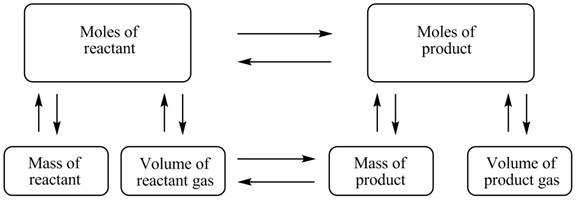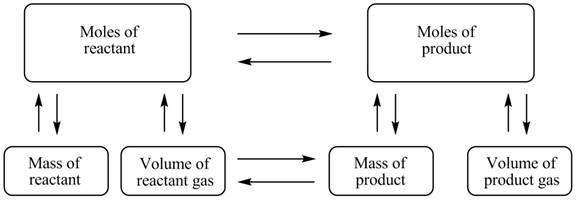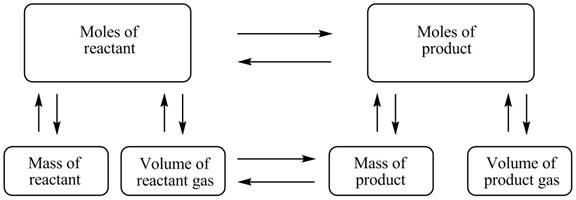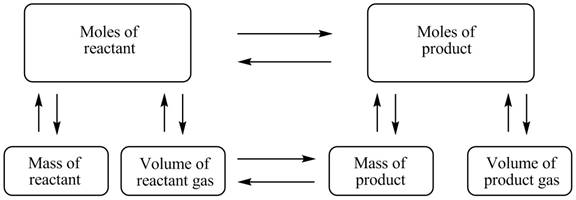
(a)
Interpretation:
The stoichiometry concept map is to be drawn and the mass of
Concept introduction:
Stoichiometry measures the amount of reactant and product consumed or formed in a
Answer to Problem 26E
The stoichiometry concept map is shown below.

The mass of
Explanation of Solution
It is given that
The given chemical reaction is stated below.
The stoichiometry concept map is shown below.

Figure 1
The chemical reaction (1) should be balanced first to calculate the mass of
The number of potassium atom and the hydrogen atom are not equal on both sides. A coefficient of
The balanced equation is stated below.
The equation (2) shows that
At
Therefore, the number of moles of
The molar mass of potassium is
The molar mass of oxygen is
The molar mass of hydrogen is
The molar mass of carbon is
The number of moles of
The mass for
Therefore, the mass of
The stoichiometry concept map is shown in Figure 1. The mass of
(b)
Interpretation:
The stoichiometry concept map is to be drawn and the mass of the
Concept introduction:
Stoichiometry measures the amount of reactant and product consumed or formed in a chemical reaction. It gives the relationship between the reactants and products. Stoichiometry concept maps are used to determine the relation of reactant and product in terms of stoichiometry.
Answer to Problem 26E
The stoichiometry map is shown below.

The mass of
Explanation of Solution
The stoichiometry concept mass is shown below.

Figure 1
The number of potassium atom and the hydrogen atom are not equal on both sides. A coefficient of
The balanced equation is stated below.
The equation (2) shows that
The molar mass of
The mass calculated of
The number of moles of
The molar mass of potassium is
The molar mass of oxygen is
The molar mass of carbon is
The mass of
The number of moles of
The mass for
Therefore, the mass of
The mass of
Want to see more full solutions like this?
Chapter 15 Solutions
Introductory Chemistry: Concepts and Critical Thinking (8th Edition)
- 62 Ammonium dinitramide (ADN), NH4N(NO2)2, was considered as a possible replacement for aluminium chloride as the oxidizer in the solid fuel booster rockets used to launch the space shuttle. When detonated by a spark, AND rapidly decomposes to produce a gaseous mixture of N2,O2, and H2O. (This is not a combustion reaction. The ADN is the only reactant.) The reaction releases a lot of heat, so the gases are initially formed at high temperature and pressure. The thrust of the rocket results mainly from the expansion of this gas mixture. Suppose a 2.3-kg sample of ADN is denoted and decomposes completely to give N2,O2, and H2O. If the resulting gas mixture expands until it reaches a temperature of 100°C and a pressure of 1.00 atm, what volume will it occupy? Is your answer consistent with the proposed use of ADN as a rocket fuel?arrow_forwardThe equation for the oxidation of phosphorus in air is P4(s) + 5 O2(g) P4O10(s). Identify the reactants and products and the stoichiometric coefficients. To what do the designations s and g refer?arrow_forwardDefine the joule in terms of SI base units.arrow_forward
- How does hydraulic fracturing differ from previously used techniques for the recovery of natural gas from the earth?arrow_forwardPhosphorus pentachloride decomposes according to the chemical equation PCl5(g)−⇀↽−PCl3(g)+Cl2(g)Kc=1.80 at 250 ∘CPCl5(g)↽−−⇀PCl3(g)+Cl2(g)Kc=1.80 at 250 ∘C A 0.2682 mol0.2682 mol sample of PCl5(g)PCl5(g) is injected into an empty 2.80 L2.80 L reaction vessel held at 250 ∘C.250 ∘C. Calculate the concentrations of PCl5(g)PCl5(g) and PCl3(g)PCl3(g) at equilibrium. [PCl5]= [PCl3]=arrow_forwardCaCO3(s) = Cao (s)+CO2 (g) When heated strongly, solid calcium carbonate decomposes to produce solid calcium oxide and carbon dioxide gas, as represented by the equation above. A 2.0 mol sample of CaCO3(s) is placed in a rigid 100. L reaction vessel from which all the air has been evacuated. The vessel is heated to 898°C at which time the pressure of CO2(g) in the vessel is constant at 1.00 atm, while some CaCO3(s) remains in the vessel. a. Calculate the number of moles of CO2(g) present in the vessel at equilibrium. b. Write the expression for Kp, the equilibrium constant for the reaction, and determine its value at 898°C.arrow_forward
- The human body burns glucose (C6H12O6) for energy according to this chemical reaction: C6H12O6+6O2→ 6CO2+6H2O The products of the reaction are carbon dioxide CO2 and water H2O Interestingly, all of the carbon dioxide and much of the water exits the body through the lungs: on every breath, the average person exhales 500.mL of air, which is typically enriched to 4% CO2 and 5% water vapor by volume. In short, when a person loses weight by dieting, the weight that is lost actually departs his body as a gas, every time he exhales. Each kilogram of body fat lost requires exhaling about 2.9kg of carbon dioxide. Calculate how many breaths it takes an average person to "exhale" 0.50kg of fat. Round your answer to the nearest thousand. You'll need to know that the density of CO2 is 2.0 kg/m^3 .arrow_forwardConsider a reaction between magnesium metal, Mg, and hydrogen chloride (HCe) to produce aqueous magnesium chloride and hydrogen gas. How many liters of hydrogen gas at STP will be producd when 2.430 g of magnesium reacts with an excess of hydrochloric acid? (MM of Mg = 24.30 g/mol) Mg(s) + 2HCC(aq) → MgCl2(aq) + Hig) O 2.24 L H2 O 4.48 L H2 O 11.3 L H2 O22.4 L H2 O 5.60 L H2arrow_forward5) Consider the reaction below. Co(g) + 2H¿(g) → CH,OH(g) 1.5 L of hydrogen gas and 3.5 L of carbon monoxide gas, both at 45 °C and 1.28 atm are in separate containers separated by a value. When the value is opened the two gases mix and react, according to the above reaction. a) Please determine the limiting reagent and the theoretical yield. b) If the percent yield is 67.3%, what is the concentration of the product in the final reaction mixture? c) What is the partial pressure of the product in the final reaction mixture?arrow_forward
- When a large evacuated flask is filled with argon gas, its massincreases by 3.224 g. When the same flask is again evacuatedand then filled with a gas of unknown molar mass, the massincrease is 8.102 g. (a) Based on the molar mass of argon,estimate the molar mass of the unknown gas. (b) What assumptionsdid you make in arriving at your answer?arrow_forwardEffervescent tablets contain both citric acid (C6H8O7) and sodium bicarbonate (NaHCO3) and release carbon dioxide gas when dissolved in water as well as forming trisodium citrate (Na3C6H5O7) and water. A typical effervescent tablet contains 1.00 g of citric acid and 1.92 g sodium bicarbonate. (a) Assuming that carbon dioxide acts as an ideal gas, determine the work done due to the evolution of carbon dioxide by the dissolution of one effervescent tablet in water at 25.0 °C and atmospheric pressure (1 atm i.e. 101325 Pa).arrow_forward[References] A steel cylinder contains 5.00 moles graphite (pure carbon) and 5.00 moles O2. The mixture is ignited and all the graphite reacts. Combustion produces a mixture of CO gas and CO2 gas. After the cylinder has cooled to its original temperature, it is found that the pressure of the cylinder has increased by 40.0%. Calculate the mole fractions of CO, CO2, and O2 in the final gaseous mixture. Mole fraction of CO = Mole fraction of CO2 Mole fraction of O2 = Submit Answer Try Another Version 3 item attempts remaining Visitedarrow_forward
 General Chemistry - Standalone book (MindTap Cour...ChemistryISBN:9781305580343Author:Steven D. Gammon, Ebbing, Darrell Ebbing, Steven D., Darrell; Gammon, Darrell Ebbing; Steven D. Gammon, Darrell D.; Gammon, Ebbing; Steven D. Gammon; DarrellPublisher:Cengage Learning
General Chemistry - Standalone book (MindTap Cour...ChemistryISBN:9781305580343Author:Steven D. Gammon, Ebbing, Darrell Ebbing, Steven D., Darrell; Gammon, Darrell Ebbing; Steven D. Gammon, Darrell D.; Gammon, Ebbing; Steven D. Gammon; DarrellPublisher:Cengage Learning Introductory Chemistry: A FoundationChemistryISBN:9781337399425Author:Steven S. Zumdahl, Donald J. DeCostePublisher:Cengage Learning
Introductory Chemistry: A FoundationChemistryISBN:9781337399425Author:Steven S. Zumdahl, Donald J. DeCostePublisher:Cengage Learning Chemistry & Chemical ReactivityChemistryISBN:9781337399074Author:John C. Kotz, Paul M. Treichel, John Townsend, David TreichelPublisher:Cengage Learning
Chemistry & Chemical ReactivityChemistryISBN:9781337399074Author:John C. Kotz, Paul M. Treichel, John Townsend, David TreichelPublisher:Cengage Learning Introduction to General, Organic and BiochemistryChemistryISBN:9781285869759Author:Frederick A. Bettelheim, William H. Brown, Mary K. Campbell, Shawn O. Farrell, Omar TorresPublisher:Cengage Learning
Introduction to General, Organic and BiochemistryChemistryISBN:9781285869759Author:Frederick A. Bettelheim, William H. Brown, Mary K. Campbell, Shawn O. Farrell, Omar TorresPublisher:Cengage Learning
 Chemistry: An Atoms First ApproachChemistryISBN:9781305079243Author:Steven S. Zumdahl, Susan A. ZumdahlPublisher:Cengage Learning
Chemistry: An Atoms First ApproachChemistryISBN:9781305079243Author:Steven S. Zumdahl, Susan A. ZumdahlPublisher:Cengage Learning





